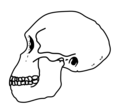| Homo habilis Temporal range: | |
|---|---|
 | |
| Reconstruction of KNM-ER 1813 at the Naturmuseum Senckenberg, Germany | |
| Scientific classification | |
| Kingdom: | Animalia |
| Phylum: | Chordata |
| Class: | Mammalia |
| Order: | Primates |
| Suborder: | Haplorhini |
| Family: | Hominidae |
| Genus: | Homo |
| Species: | †H. habilis |
| Binomial name | |
| †Homo habilis Leakey et al., 1964 | |
| Synonyms [1] | |
| |
Homo habilis (lit. 'handy man') is an extinct species of archaic human from the Early Pleistocene of East and South Africa about 2.4 million years ago to 1.65 million years ago (mya). It is among the oldest species of archaic humans. [2] [3] Suggestions for pushing back the age to 2.8 Mya were made in 2015 based on the discovery of a jawbone. [4] Upon species description in 1964, H. habilis was highly contested, with many researchers recommending it be synonymised with Australopithecus africanus , the only other early hominin known at the time, but H. habilis received more recognition as time went on and more relevant discoveries were made. By the 1980s, H. habilis was proposed to have been a human ancestor, directly evolving into Homo erectus , which directly led to modern humans. This viewpoint is now debated. Several specimens with insecure species identification were assigned to H. habilis, leading to arguments for splitting, namely into " H. rudolfensis " and " H. gautengensis " of which only the former has received wide support.
Contents
- Taxonomy
- Research history
- Classification
- Anatomy
- Skull
- Build
- Limbs
- Culture
- Society
- Diet
- Technology
- See also
- References
- External links
H. habilis brain size generally varied from 500 to 900 cm3 (31–55 cu in). The body proportions of H. habilis are only known from two highly fragmentary skeletons, and is based largely on assuming a similar anatomy to the earlier australopithecines. Because of this, it has also been proposed H. habilis be moved to the genus Australopithecus as Australopithecus habilis. However, the interpretation of H. habilis as a small-statured human with inefficient long-distance travel capabilities has been challenged. The presumed female specimen OH 62 is traditionally interpreted as having been 100–120 cm (3 ft 3 in – 3 ft 11 in) in height and 20–37 kg (44–82 lb) in weight assuming australopithecine-like proportions, but assuming humanlike proportions she would have been about 148 cm (4 ft 10 in) and 35 kg (77 lb). Nonetheless, Homo habilis may have been at least partially arboreal like what is postulated for australopithecines. Early hominins are typically reconstructed as having thick hair and marked sexual dimorphism with males much larger than females, though relative male and female size is not definitively known.
H. habilis manufactured the Oldowan stone tool industry and mainly used tools in butchering. Early Homo, compared to australopithecines, are generally thought to have consumed high quantities of meat and, in the case of H. habilis, scavenged meat. Typically, early hominins are interpreted as having lived in polygynous societies, though this is highly speculative. Assuming H. habilis society was similar to that of modern savanna chimpanzees and baboons, groups may have numbered 70–85 members. This configuration would be advantageous with multiple males to defend against open savanna predators, such as big cats, hyenas and crocodiles. H. habilis coexisted with H. rudolfensis, H. ergaster / H. erectus and Paranthropus boisei .










